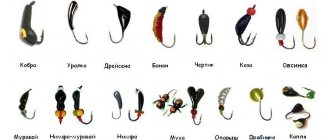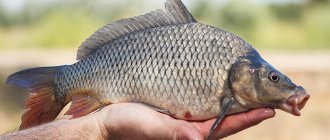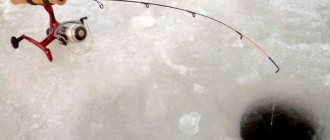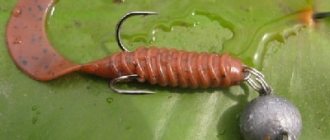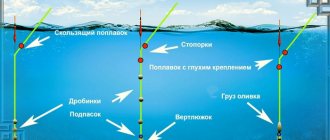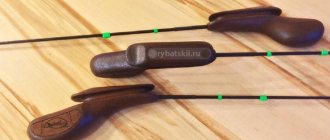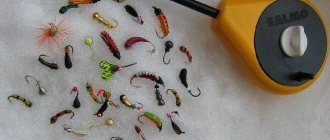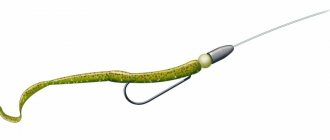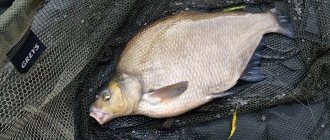Yuri 02.11.2020 331
Many young anglers mistakenly believe that fishing success depends on luck or luck. In reality, luck is an abstract concept that has little to do with successful fishing. One of the decisive factors is gear that is properly selected for fishing conditions.
In this article we will talk about an amazing and interesting equipment with the funny name “pokatok”. Fishing by rolling, or as it is called differently - “pulling”, is effective both in winter and in summer.
Pull (pull, roll)
Pulling (pulling, rolling) is, without exaggeration, a great method of fishing on river currents, and has recently gained popularity on many rivers in our country. And even those fishermen who are accustomed to sitting on the “fish tins” of old rivers and lakes in winter were so impressed by fishing with pull-ups and catches of pull-ups that they abandoned their homes and in friendly rows went out into the river spaces to real bream, large roach, ide, silver bream and other worthy fish.
Apparently, the success of retrieval on our rivers is associated with the behavioral characteristics of winter fish. After all, inspired by ice successes, anglers have repeatedly tried to fish with this tackle in open water from a boat, but neither in summer, nor even in late autumn (on the eve of freeze-up) in lead water was there anything special about the pull, but in winter...
On some rivers this tackle has become very widespread, and the technique of pull-up fishing has been worked out to perfection. There is, however, a small gap here - what should you call a catcher who loves pulling? Suspender? Pull-up? Probably, the first option is still more suitable: “suspender” - in the image and likeness of “float - floater”.
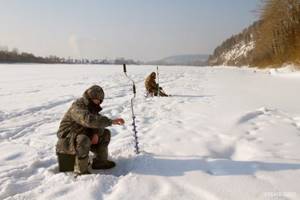
Benefits of skating
Stream fishing takes place without the use of bait, which is an advantage, but sometimes bait is used. You should not throw bait into the main hole. Holes are drilled in the ice in a row, close to each other. They throw fertilizer into them. A path will emerge, which helps lure prey to the main hole.
To feed the fish, take sweet crumbs and combine them with small bloodworms. In this case, the profit should be at least half.
The main advantages of this kind of fishing are mobility and a good catch.
Source: ribaku.info
The principle of pull-up fishing
The principle of such fishing is based on fishing not with the flow, but against it, as skilled fishermen say - so that the fish goes stunned. And this moment of fishing stands out sharply from the canons of the general concept of river fishing with natural bait, which note that the bait must either float freely with the flow, or slow down, or drag along the bottom, or be motionless (donka, half-bottom). And in the pull-up, the wiring is done against the current, and it is not stupid careless small things that are caught, but good, large river fish.
Seasoned fishermen note that winter fishing on the river is always of increased complexity, both in terms of the choice of place where the fish are densely concentrated, and in the methods of supplying bait to the fish, but, in any case, fishing on the river in winter with other gear is quite difficult. This fishing method is good throughout the entire ice season, it also successfully combats the dead-winter lack of bite, but is especially effective on the last ice. But before we start talking about tactics and fishing techniques, let’s decide directly on the tackle, taking a typical sample as a sample - there is no big difference in the design of the tackle, which indicates many years of fine-tuning.
Bait and groundbait for ice fishing
The main winter bait is bloodworm (raspberry), which is good for catching carp fish. Predatory fish also do not disdain them. In some cases, good results can be achieved by fishing with maggots, worms, burdock moth larvae and other baits of animal origin.
Sometimes a small ball of foam is hooked onto the hook. It is used as an independent bait or in combination with animal baits. Then the equipment acquires additional buoyancy and attractiveness to fish.
Roll fishing is quite passive, so in order not to be left without fish, you can feed the fishing spot. To do this, use ready-made winter mixtures from the store or prepare the bait mixture yourself. Standard winter feeders are used to deliver feed.
The simplest bait will be moistened breadcrumbs mixed with food bloodworms, which can be flavored with bite activators. In general, the topic of winter bait is very broad and requires separate consideration for each type of fish and time of year. We suggest you read the article about making winter bait for catching bream.
It should be noted that many fishermen do not use bait at all, preferring to actively search for fish. It is believed that the fish are attracted to the tackle itself. When you tap the bottom with a weight, “clouds” of turbidity from the bottom sediments rise, which attract fish.
Thus, the decision to feed or not must be made by the fisherman himself, focusing on local fishing conditions.
Tackle design
The fishing rod, as a rule, is used “on-board”, about a meter long. The rod comes complete with a regular inertial “wire” reel. Many people are starting to use a spinning reel, which has its advantages when fishing, especially at long distances. When choosing a suitable reel, fishermen, as usual, have a strictly individual approach, and each fisherman, during the fishing process, understands which model is suitable specifically for his requirements.
Line from 0.18 mm (not thinner) to “infinity” - as long as the equipment is pulled by the current.
The pull-up equipment looks like this:
A sliding olive weighing from 1 to 20 g is put on the fishing line (the specific weight is selected depending on the strength of the current in the fishing area). Many fishermen refuse a separate leash, simplifying the equipment as much as possible, making it extremely reliable - the hook is tied directly to the main fishing line. Any additional knot on the rig is a big evil also because during the fishing process the line is regularly “sawed” against the rather sharp edges of the hole, because the fishing is carried out in the current. The stopper for the olive is not a traditional lead pellet clamped on a fishing line, but a cambric, stopped, for example, by a piece of a match (so that the fishing line does not get chewed). Hooks No. 5-6 (according to the recommended numbering), the main bait is a bunch of bloodworms, usually the bloodworms are hung without unnecessary greed, as far as it will go on the hook. And in order not to tear the delicate bait, even if a large fish bites, the hooks are selected thinner.
Collecting tackle
Standard tackle is a jig with a reelless bait and a bloodworm. Sometimes equipment with a lead weight is used. Above the sinker, attach a leash with a hook or jig.
The gear is collected like this. A base line and a lead sinker are wound onto the reel. The fisherman attaches a swivel of the optimal size to hold the roller on the structure. A lead sinker is placed on the fishing line. Then they attach a leash and a hook on top.
Rod and reel
The basis of summer gear is a small rod 1.5 m long. Important characteristics are sensitivity, an ordinary inertial coil.
For winter construction, a fishing rod and reel are also used. The whip can be made from part of an old spinning rod. The handle is cut from balsa wood. The winter fishing rod is light and small in size.
Cargo selection
The winter fishing rod is equipped with a lead sinker, which has a round shape. The main task is to roll freely along the bottom in the direction of the current. The weight of the load is chosen taking into account the strength of the current.
Line and leashes
The fishing line for summer tackle has a diameter of 0.2−0.25 mm. It must be threaded through the rings. They apply a sinker. A leash with a hook is tied to the end of the fishing line.
A needle must be attached to the ring. It can be made like this: cut off a piece of steel wire. A section of 15 cm is needed. One end is sharpened, and a lock is made at the other to connect the element and the ring.

Hooks
The hook is knitted onto the equipment structure last. The Japanese modification is suitable for skating fishing.
Pull-up fishing
The equipment is launched into the hole, the olive falls to the bottom. The main condition for success is to pull the bait against the current. But first, the equipment needs to be floated downstream. By moving the rod, the olive is torn away from the bottom soil and at the same time an additional piece of fishing line up to 3 m long is released from the reel - the olive goes downstream, traveling a certain distance until it falls to the bottom again.
The release of equipment can be either short or reach fifty (or even more) meters. It would seem that it is at this moment of moving downstream that the vast majority of bites should occur, as, for example, happens when fishing with a summer “running bottom”, which is somewhat reminiscent of a pull-up. However, experienced winter fishermen note that almost all bites occur during subsequent tightening of the equipment against the current, when the bait is brought back to the hole. Pulls against the current (with subsequent pauses) are performed with a rod with a smoothly increasing acceleration, during which bites are common. If there are no bites, then we move a little to the left or to the right, looking for fish, because on the river it often happens that all the bites are brought by a strictly defined stream, which is so important to get on. It happens that you run into a working fish and drag fish one after another, but you drill half a meter to the right or to the left, and there are no more bites.
Fishing principle
In winter, fishing on a frozen river has a number of features. This includes the current, which carries the equipment away from the baited point under the hole, and heterogeneous ice at the beginning and end of winter, and cautious fish that are afraid of the sound of an ice pick or ice drill. All these problems can be solved with the help of winter skating gear.
It is not possible to buy ready-made tackle in all fishing stores, so novice fishermen will have to practice making it, relying on the advice of experienced comrades. The fishing rod consists of a rod with a reel and nod, a supply of monofilament of 20-30 m, a sinker and a leash with a hook. The principle of fishing is to periodically release the equipment downstream. The bait rolls along the bottom, which is why the fishing method received the corresponding name. In some regions, a similar option for catching fish is called pull fishing. There are two types: static and dynamic.
- With a static (passive) approach, the fishing rod is placed motionless near the hole, only occasionally a pull is made. The use of such a scheme is justified when a certain area under the hole is baited and the fish is in close proximity to the angler.
- Dynamic (active) fishing involves constant use of gear. The bait is then released, then pulled up, sending the equipment at a distance of 10-15 m from the hole. This type of fishing is considered search fishing. With its help, you can find feeding fish over a significant section of the river.
What kind of fish can you catch using a rolling tackle?
Source: fishelovka.com
Until recently, stream fishing was much more popular than it is now. On the ride we caught ide, roach and bream. Modern fishermen have practically forgotten about this ancient method of fishing. But downstream fishing is very exciting and effective.
VKontakte Facebook Twitter Google+ My world
Stream fishing in summer
Tackle
Summer tackle is based on a compact rod no more than one and a half meters long with high sensitivity and a conventional inertial reel. A fishing line with a diameter of 0.2 to 0.25 mm is threaded through the rings. Then a sinker or cambric is put on. A winding ring is attached to the end of the fishing line, to which, in turn, a leash with a hook is attached. Leash length is about 45 cm.
Also, a needle is attached to the winding ring , which is done as follows. A piece of steel wire 15 cm long is cut and sharpened at one end. On the other side of the needle you need to make a lock to connect to the ring.
Preparing for fishing
They fish by skating only in rivers , since the presence of a current is a prerequisite for this method. In summer, in almost all cases it is more effective to fish from a boat.
The preparatory stage is one of the most important in fishing. Careful study of the terrain and identification of possible fish sites are the main secrets of success. Ideally, the preparatory stage takes 2–3 days.
Since split peas are most often used as bait, they should also be fed. Peas for bait are pre-soaked and boiled until they are well crushed. However, it should not fall apart on its own, so you will still have to monitor the cooking process.
For rolling fishing, the boat must be stationary. The anchor is lowered at the fishing spot directly above the hole. The more stable the boat is , the better.
You need to start fishing with bait, which is produced in a special way. About a dozen peas are strung on a needle and the tackle is lowered to the bottom. When the needle touches the bottom, you need to make a sharp cut so that the peas fall off and are carried away with the current. The same thing needs to be done one or two more times.
Now you need to choose a pea that will become bait. The fish most readily take large and cracked ones.
This article will help you in choosing a fishing line for a spinning rod.
In this article we will talk about catching perch with a float rod.
Fishing technique
The tackle sinks to the bottom. It is important that the line is taut and the sinker holds the tackle in place. If after 2-3 minutes the fish does not bite , you need to let the line go so that the current pulls it into an arc. Then raise the tackle and lower it again. All this is done to lower the gear downstream.
If the fish still does not bite, the procedure must be repeated. When the current will no longer carry away the tackle , you need to pull it out and start all over again. Rip the pea off the hook with a sharp hook.
If 5-6 transactions turned out to be ineffective, do not despair. With each pea left, the likelihood of a bite increases.
The bite when fishing on a roller is almost unnoticeable. This is why you need the most sensitive rod possible. Timely and instant hooking is a prerequisite for successful fishing.
As soon as the fish begins to swallow the pea, the end of the rod gently bends towards the water. There are a few seconds until the fish takes the peas off the hook. It is during these few seconds that you need to make a sharp hook.
If the fish does leave, you need to pick the pea in the usual way and continue the familiar cycle.
Fishing in winter on the ride
For obvious reasons, winter skating fishing is done while standing. One of the main conditions for success is knowledge of the terrain, the nature and strength of the current in the chosen fishing location. Most often they are caught in wintering pits, where the largest concentrations of peaceful fish are located.
The hole needs to be drilled upstream two meters from the beginning of the dump.
The sinker is lowered to the bottom and released a meter downstream. Then the tackle is stopped and pulled towards itself a couple of times. Usually after this the bite begins.
If there is no bite , you need to lower the tackle downstream another meter. Repeat the same until the length of the fishing line reaches 15 m.
Bites also occur when the fishing line is returned. If you reel in 2 m portions, you can stumble upon a perch. After 5 postings, the fishing location is changed. Winter fishing requires compliance with some seemingly insignificant rules.
Firstly, it is worth remembering that in the cold, carbon fiber and composite whips break easily and need to be cooled before fishing. To do this, you need to hold them in the air for about 15 minutes. All this time, the angler must keep the tackle under tension so that it always remains on the bottom.
Secondly, if the bite occurs far from the hole, you need to move a few meters away from it in order to lay the line as evenly as possible. Select the rest by hand, as in the case of other winter gear. Otherwise, the wind may twist the line into a lump , which will be impossible to untangle in the cold. If the wind is very strong, it is better to choose fishing line using a reel.
Are you interested in silicone baits for pike perch? Our article will tell you more about this.
And here you will learn how to fish with the famous spinnerbait.
Bait in the hole
Traditional ice fishing does not involve the use of bait, but sometimes it works well. Of course, there is no point in throwing bait into the main hole. You need to drill several holes in a row nearby and throw the bait there. Thus, you will get a kind of feeding path that will lure the fish to the main hole.
For bait, use confectionery crumbs together with small bloodworms.
Groundbait should always include an element that is used as bait. If bloodworms are used as bait , then the bait should contain at least half of it.
Some tricks
If the presence of fish is obvious, but there are still no bites, use fishing gear. They run the rig through the pit two or three times , jerking the rod frequently and sharply. In some cases, the fish becomes active and grabs the bait.
Sometimes there are a lot of fish at shallow depths, and in order not to scare them away you need to slightly alter the gear. To do this, take a thicker line and reduce the weight of the sinker. 5 meters from the fish site into which the tackle is thrown. Thus, the angler is in one place and fishes in another.
Without a doubt, stream fishing has fallen out of favor for a reason. The formation of reservoirs has significantly reduced the number of fishing areas with currents, that is, convenient for this type of fishing. However, if there is a river nearby, this wonderful method of fishing is definitely worth remembering.
Video
We present to you a video on fishing in the winter while skating.
This article will tell and show you how to properly catch pike perch at night.
Here we will talk about fishing with jigs.
On our website https://lovisam.net there is still a lot of interesting and useful information about catching different types of fish.
Source
Source: my-ribalka.ru
Nowadays, ice fishing has significantly decreased in popularity. But before, they used it to readily catch bream, roach, and ide. This type of fishing is truly exciting and effective.
Features of gear
Summer gear consists of:
- A compact and sensitive rod, the length of which does not exceed 1.5 m.
- An ordinary inertial coil.
A fishing line, the diameter of which is 0.2-0.25 millimeters, is threaded through the rings. Next, the cambric and sinker are attached. A ring is tied to the end of the scaffolding, and a leash and hooks are attached to it. Moreover, its length does not exceed 45 centimeters.
to the winding ring. It is made according to the following principle: a 15-centimeter piece is cut off from the steel wire. Then one end of this segment is sharpened. On the opposite side, a lock is formed to connect the ring and the needle.
Using the skating rink in summer
Roll fishing is carried out mainly on the river, because this species requires the presence of currents. In the summer, you should fish not from the shore, but from a boat. Preparation for fishing is a responsible event that affects the future catch. It is important to study the topography of the reservoir and identify possible fish sites. It will be great if the fisherman devotes at least two days to this stage.
Roll fishing involves stopping the boat in one place. The anchor is released directly above the pit. You should position your watercraft as stable as possible.
The fishing process begins with luring fish with a bait mixture. To do this, ten peas must be strung on a needle, and then lower the rod to the bottom. When the tackle reaches the bottom surface, you need to make a quick hook, then the peas will fall off the needle and be carried away by the current. It is recommended to do this a couple of times. Then you need to select a pea for bait. Fish prefer large and slightly cracked specimens.
Fishing technique for skating in summer
From the beginning, the angler lowers the rod to the bottom. The fishing line should be like a string - tight and stretched. The role of the sinker in this case is to hold the tackle in one place. If several minutes are unsuccessful, you should lower the line a little, and the current will pull it out in an arc. Then you need to raise the rod for a while and then lower it again. This is done to lower the gear downstream.
If after this the bite does not occur, the procedure is repeated again. When the tackle is no longer carried away by the current, it is worth pulling it out to start fishing again. The bait is torn off the hook by means of a sharp hook. If even the sixth transaction did not bring any results, you should not despair. Each pea left in the water increases the chances of a successful bite.
Fishing on the rink is accompanied by barely noticeable bites. Therefore, when choosing a fishing rod, it is important to be guided by its sensitivity. Lightning-fast and timely hooking is a prerequisite for successful fishing.
By the time the prey begins to swallow the pea, the end of the tackle will barely tilt toward the water surface. At a time when the fish has not yet managed to get off the hook, a quick hook is carried out. If the desired prey managed to escape, then the bait is picked using the already proven method in order to repeat the familiar procedure.
There is no doubt that downstream fishing has lost its former relevance for the reason that the resulting reservoirs reduce the number of fishing spots on the river with a current that are convenient for this type of fishing. But when there is a suitable river nearby, then this wonderful method definitely needs to be tried.
Source: rybsoveti.ru
Summer fishing video
The right load
It is very important to match the required weight of the olive to the depth and speed of the current, but this is not as difficult as it might seem at first. Two or three strokes and you can immediately see whether the olive has fallen or whether it is too light or heavy. They say that the easiest way to master the pull-up is for spinners who often fish with a jig step. These two methods of fishing have a lot in common: here you jig with rubber, and here with bloodworms.
The great advantage of the pull-up is that you can fish with it on changes in the bottom and on the most difficult streams - on the return, whirlpools, that is, where the fish often stand in winter. Try fishing here in the summer with a float rod in the wiring! But in winter, pulling up is the best thing; you control the equipment well in any case, because bites occur when pulling up, that is, in cases where the line is always well stretched.
Pull-up - the simplest possible equipment
Often, experienced fishermen take two or three fully equipped tackles with them on the ice (in decent frost, fiddling with tying and tying equipment is not a pleasant task). However, even in well-known places it may be necessary to change the olive to a heavier one or, conversely, to a lighter one. It is clear that on a lineless rig, replacing the olive will require removing the hook and re-tying it. Is this justified? After all, for example, you can tighten an easily removable olive with a side slot into a through hole, and the slot can be closed with a thick cambric. However, some experienced hoisters believe that the rigging of a hoisting tackle should be as simple and reliable as possible, and it never hurts to re-tie the hook, because it is the knot that holds the hook that is the weakest point of the rig, requiring increased attention. But when fishing in river currents, the pull-up rig is subject to enormous loads: constant twisting of the fishing line, cutting on the edges of the hole, regular transitions from place to place, plus protracted fishing for large fish from a long distance. In such difficult dynamic fishing conditions, the equipment simply must be as simple as possible, which can be untangled or tied in a matter of minutes.
What components are needed to assemble the roller?
To assemble the ride you will need:
- Rod;
- Coil (spinless or wire);
- Line (main and leader);
- Sinker (olive or ball);
- Swivel;
- Stop bead;
- Hook.
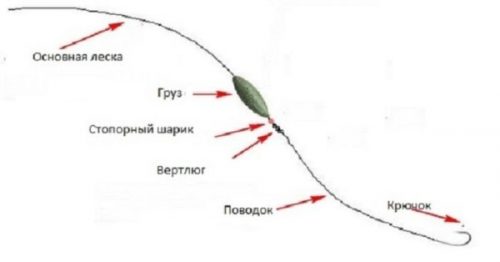
For downstream fishing, choose a durable fishing rod from 50 to 120 centimeters long with a large diameter reel. The main requirements for a fishing rod are sufficient rigidity and length. Some people make a fishing rod using a broken spinning rod, while others look for a suitable one in the store.
A long fishing rod is necessary for comfortable control of the tackle, since the load is gradually carried away by the current and needs to be pulled back or released further with fairly wide movements. In general, long upward pulls and then a smooth lowering of the rod towards the hole are one of the elements of fishing with this tackle.
A large diameter reel is needed to speed up work with tackle and mobility when moving. Due to the fact that fishing is carried out in currents and depths, sometimes in order to get to the fish you have to let a very long piece of fishing line go under the water.
The main line with a diameter of approximately 0.2-0.3 mm is wound onto the reel. When choosing the diameter of the fishing line, you need to understand that with greater depth and/or strength of the current, a thicker fishing line will “sail” more, so a heavier load will be required, which can make the tackle cumbersome.
A lead or tungsten weight with a hole is placed on the fishing line. The shape of the load is olive or ball.
The weight of the sinker must correspond to the diameter of the main line, the depth and current in the river. Typically this is 3 to 6 grams, but weights up to 20 grams can be used.
Weights with a PVC tube inside work well, because they do not fray the fishing line and glide along it perfectly.
The sinker must slide freely along the main line to provide the angler with the opportunity to play with the bait.
Then, behind the load, a plastic bumper ball (stop bead) is placed on the main line so that the load does not hit the swivel.
Next, the swivel is tied. A leash made of thinner and preferably high-quality fishing line is tied to it. The last element is the hook that we will tie to the leash.
You can purchase any swivels and locking beads, the main thing is not to use outright Chinese “cheap” ones, since due to a low-quality swivel, if it breaks, you may lose the long-awaited trophy.
The leashes use a thinner line, the diameter of which is selected based on the expected size of the local fish. As a rule, this is a fishing line with a diameter of 0.12-0.15 mm.
The length of the leash depends on the weight of the load used and the object being fished. When choosing a light one, you can set a leash of about 40 centimeters, and with a heavy load and when fishing in the water column, the leash is set from 40 centimeters to 1 meter.
If the bite is weak and capricious, or if there are no large fish in the reservoir, it is necessary to use a thinner line for the leash, which can have a positive effect on the number of fish caught.
Since the leash uses a thinner line, it is better to purchase high-quality products from well-known manufacturers Marvel, Owner for these purposes.
The hook is selected based on the size of the expected catch. For medium-sized roach we take No. 14, for large specimens and bream we use No. 12.
Often unfavorable conditions will also dictate the angler's hook size, for example when fish activity is low, a smaller hook size is recommended. It is also recommended to reduce the hook size when the bite is capricious, when there are many empty bites.
The fisherman always needs to have with him several weights of different weights, swivels, hooks, different sizes and a supply of leading line. Since there may be breaks in the gear or the need to change it to suit specific fishing conditions.
The nod when fishing on a roll gives the angler the opportunity to determine the moment when the load sinks to the bottom of the reservoir, as well as track bites in order to determine in time when to hook.
The nod should be sensitive and respond instantly to the slightest touch of bream and roach to the bait.
Anglers often use spring nods or silicone tubes for downstream fishing. Some people don’t use a nod at all, focusing on the sensitive tip of the rod as when fishing with a feeder and tactile sensations. Understanding whether a nod is required comes with fishing experience.
